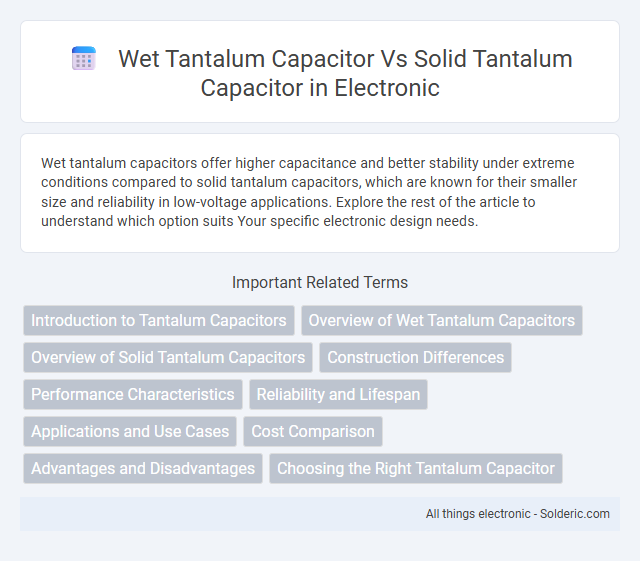Wet tantalum capacitors offer higher capacitance and better stability under extreme conditions compared to solid tantalum capacitors, which are known for their smaller size and reliability in low-voltage applications. Explore the rest of the article to understand which option suits Your specific electronic design needs.
Comparison Table
| Feature | Wet Tantalum Capacitor | Solid Tantalum Capacitor |
|---|---|---|
| Electrolyte Type | Liquid (wet) | Solid manganese dioxide or polymer |
| Capacitance Range | Up to several thousand uF | Typically up to a few hundred uF |
| Voltage Rating | Up to 100V or higher | Up to 50V generally |
| ESR (Equivalent Series Resistance) | Lower ESR than solid types | Higher ESR compared to wet tantalum |
| Reliability | Good, but prone to leakage under physical damage | High reliability, but susceptible to catastrophic failure if voltage is exceeded |
| Leakage Current | Higher leakage due to liquid electrolyte | Lower leakage current |
| Size | Larger size due to design | Smaller, compact size |
| Applications | High capacitance and voltage applications like power supplies | Consumer electronics, decoupling, filtering |
| Failure Mode | Gradual degradation, leakage | Sudden short circuit |
Introduction to Tantalum Capacitors
Tantalum capacitors are electronic components known for their high capacitance and reliability in compact sizes, utilizing tantalum metal as the anode material. Wet tantalum capacitors contain a liquid electrolyte, offering higher voltage ratings and better performance under surge conditions compared to solid tantalum capacitors. Solid tantalum capacitors use a solid manganese dioxide or polymer electrolyte, providing lower equivalent series resistance (ESR) and enhanced frequency response for mobile and high-frequency applications.
Overview of Wet Tantalum Capacitors
Wet tantalum capacitors feature a liquid electrolyte, offering superior pulse load capabilities and better performance in high-voltage applications compared to solid tantalum capacitors. Their construction allows for self-healing properties, resulting in greater reliability under stress and transient conditions. You can rely on wet tantalum capacitors for enhanced durability in aerospace, military, and industrial environments where long life and stability are critical.
Overview of Solid Tantalum Capacitors
Solid tantalum capacitors feature a manganese dioxide or conductive polymer cathode material, providing excellent stability, low equivalent series resistance (ESR), and long life performance in compact sizes. These capacitors are known for their high volumetric efficiency and consistent capacitance over a wide temperature range, making them ideal for space-constrained applications requiring reliable and stable energy storage. Compared to wet tantalum capacitors, solid types offer better tolerance to mechanical stress and immunity to leakage currents, enhancing overall circuit reliability.
Construction Differences
Wet tantalum capacitors use a tantalum anode submerged in a liquid electrolyte, allowing higher voltage ratings and improved surge current handling. Solid tantalum capacitors feature a manganese dioxide or polymer solid electrolyte, providing lower ESR and better stability in compact sizes. Understanding these construction differences helps you select the right capacitor based on performance and application needs.
Performance Characteristics
Wet tantalum capacitors exhibit superior voltage stability and higher ripple current handling due to their liquid electrolyte, making them ideal for high-frequency and high-current applications. Solid tantalum capacitors offer lower equivalent series resistance (ESR) and better long-term reliability, excelling in compact, low-voltage circuits. Both types provide excellent capacitance per volume, but wet tantalum capacitors generally achieve higher capacitance values and better performance under extreme temperature variations.
Reliability and Lifespan
Wet tantalum capacitors exhibit superior reliability and longer lifespan due to their liquid electrolyte, which provides better self-healing properties and improved thermal stability compared to solid tantalum capacitors. Solid tantalum capacitors, while compact and widely used, are more prone to dielectric breakdown and have a shorter operational life under high-temperature or high-voltage conditions. The enhanced robustness of wet tantalum capacitors makes them ideal for critical applications requiring consistent performance in harsh environments.
Applications and Use Cases
Wet tantalum capacitors excel in high-voltage, high-reliability applications such as aerospace, military, and industrial equipment due to their superior voltage ratings and long lifespan. Solid tantalum capacitors are preferred in consumer electronics, telecommunications, and portable devices where compact size, stability, and low equivalent series resistance (ESR) are critical. Both capacitor types serve distinct roles in power supply filters, audio equipment, and medical devices, balancing performance requirements with environmental conditions and space constraints.
Cost Comparison
Wet tantalum capacitors generally have lower initial costs compared to solid tantalum capacitors due to simpler materials and manufacturing processes. Solid tantalum capacitors, despite higher upfront expenses, offer longer operational life and greater reliability, potentially reducing total cost of ownership in long-term applications. Cost efficiency should be evaluated based on specific usage requirements, including performance, lifespan, and environmental conditions.
Advantages and Disadvantages
Wet tantalum capacitors offer higher voltage ratings and improved ripple current handling compared to solid tantalum capacitors, making them suitable for demanding power applications. However, wet tantalum capacitors are larger, more complex, and generally less reliable in harsh environments due to potential electrolyte leakage. Your choice depends on whether you prioritize long-term stability and compact size (solid tantalum) or enhanced electrical performance with higher voltage tolerance (wet tantalum).
Choosing the Right Tantalum Capacitor
Wet tantalum capacitors offer higher reliability and voltage ratings due to their liquid electrolyte, making them ideal for high-voltage and high-reliability applications where long service life is crucial. Solid tantalum capacitors, featuring a solid manganese dioxide electrolyte, provide smaller size and superior frequency response, suited for compact electronic devices requiring stable capacitance under varying conditions. Your choice depends on application-specific needs such as operating voltage, ESR, size constraints, and environmental factors to ensure optimal performance and durability.
wet tantalum capacitor vs solid tantalum capacitor Infographic

 solderic.com
solderic.com